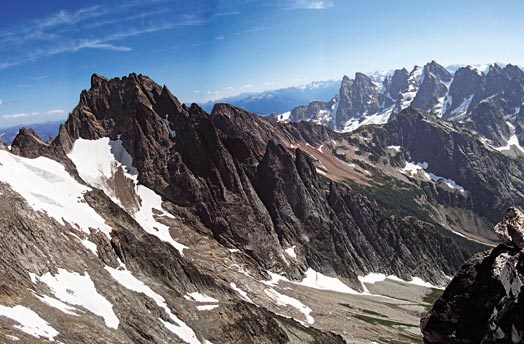
Mt. Fury, Picket Range, Washington. Mongo Ridge (VI 5.10) takes the south buttress (the mile-long skyline ridge depicted in the photo, comprising a 4,000-foot vertical rise) of the West Peak (8,320′) of Mt. Fury. One of the longest ridgelines in the lower forty-eight, the Mongo Ridge is also one of the most remote. Wayne Wallace made the first ascent of the ridge, solo, in four days in August, overcoming half a dozen gendarmes with twelve rappels, twenty-five technical pitches and much scrambling. [Photo] Michael Layton
Mt. Fury, West Peak, Mongo Ridge, First Ascent. It started with a map: the Challenger Quadrangle, showing long granite ridges and wild valleys of slide alder and devil’s club–the coolest topo of the lower forty-eight I’d ever seen. One ridge in particular caught my eye: Mongo Ridge (prenamed by my climbing partner Mike Layton), the south buttress of the West Peak (8,292′) of Mt. Fury, a mile-long, 4,000-foot vertical rise, broken by monoliths and gendarmes.
I couldn’t find any good photos to judge the rock quality, and when Mike and I opened the Haunted Wall (IV 5.9+, 2,100′) on the nearby Spectre Peak (7,840′), I couldn’t see an approach route that did not require several days of intense bushwhacking. But what if I climbed East Fury (8,280′) first and then descended to the ridge?
Fired up from Colin Haley’s slideshow about his first ascent of Mt. Moffit, I headed out at 4 a.m., August 24. Once the boat dropped me off on the other side of Ross Lake, I embarked on the usual bushwhacking. By the evening of the next day, I was alone on the top of East Fury, exhausted.
The Yvon Chouinard saying, “If you take bivouac equipment along, you will bivouac,” has become a climbers’ aphorism. But as a bivy seemed unavoidable no matter what, I decided that fast and heavy (forty-five pounds) would be the most appropriate style.
In the morning, I free soloed the first 400-foot wall (5.8). After several pitches of complicated route finding, a relatively clean ridgeline began, with the three major pinnacles I’d seen in the photo, and a fourth one that surprised me. Pinnacle #1 turned out to be a long fourth-class ridge that dropped off into a series of deep notches. Each of the dozen rappels that followed made retreat even harder to imagine.
At the top of Pinnacle #2, another rappel into a notch and a traverse across the face brought me to a steep, 400-foot prow. The first 5.9 section convinced me to rope up. A 5.10 crux brought me to the top of Pinnacle #3. Once again, I made an airy, committing rappel.
My hands cramped up as I free soloed another frightening traverse. From the top of Pinnacle #4, I could see the climb was only halfway over. I was starting to lose my focus, but at least I had that bivy gear….
I named the next section the Rooster Comb: a horizontal knife-edge traverse that demanded a precarious sort of gymnastics. Eventually, I left it, via yet another rappel, this one awkward and diagonal. A wistful John Roper had called the subsequent formation the “Pole of Remoteness,” because he figured it would be the hardest spot to reach in the Continental US. I wasn’t about to disagree.
As it grew dark, a narrow ledge system allowed me to traverse away from a 5.11 headwall and up a 5.7 notch instead. Standing on the apex of the Pole of Remoteness, I let out a long, pent-up scream. A loose-block rappel, a severed rope, a bivy and the last 500, fourth-class, feet took me to the summit of West Fury, at 10 a.m, Day 4–and to my reawakening gratitude for such truly wild places.
For me Mongo Ridge (VI 5.10) would be one of those trips my friend Eric Wolfe extols, the kind “you never fully come back from.”
–Wayne Wallace, Seattle, Washington